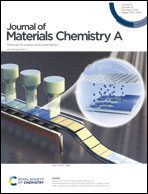Defect engineering via the F-doping of β-MnO2 cathode to design hierarchical spheres of interlaced nanosheets for superior high-rate aqueous zinc ion batteries†
Abstract
The rechargeable aqueous Zn ion battery (ZIB) is a promising candidate for next-generation energy storage technology due to its low cost, low flammability, inherent safety, and high theoretical capacity. Nevertheless, the β-MnO2 cathode material continues to be limited by inactive ion insertion and transport kinetics due to a relatively narrow tunneling pathway, thus leading to low capacity and rate capabilities. Hence, to achieve a high-performance ZIB, the presence of lattice and defect structures in the β-MnO2 is required to promote the electrochemical reactions. Herein, for the first time, a β-MnO2 cathode with a hierarchical structure consisting of spheres of interlaced nanosheets is introduced via efficient defect engineering using fluorine (F)-doping and oxygen vacancies, thus leading to improved ion insertion and transport kinetics along with an enhanced electrical conductivity. The ZIB is shown to exhibit a high energy density (288 W h kg−1 at a power density of 90 W kg−1), a superior high-rate performance (energy density of 158 W h kg−1 at a power density of 1800 W kg−1), and a capacity retention (85% after up to 150 cycles). These results highlight the potential of defect-engineered cathode materials for the enhanced electrochemical performance of rechargeable aqueous batteries.



 Please wait while we load your content...
Please wait while we load your content...